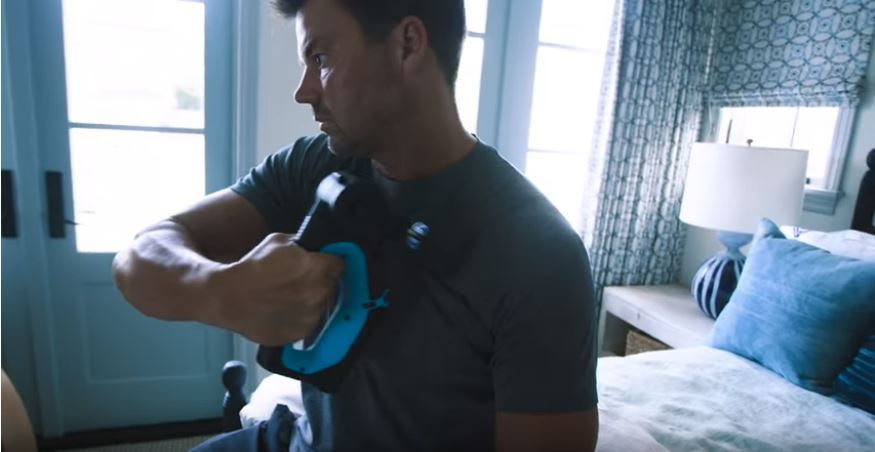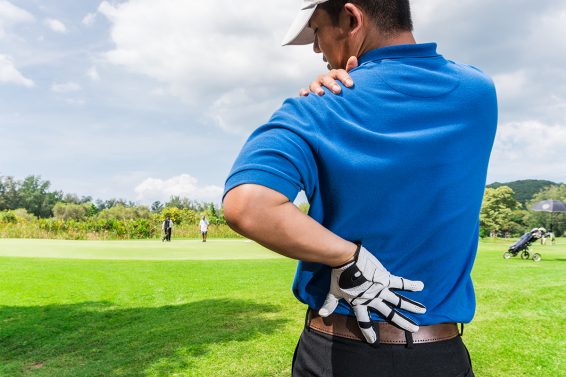If you’re an active person of any kind, then you’re probably no stranger to the aches and pains that accompany pushing your body to it’s limits These aches and pains are often caused by tight muscles. Tight muscles are often very common among runners as running is constantly challenging every muscle in our legs, which can lead to not only tightness, but imbalances. While there is a variety of reasons that could be causing your soreness, you’re probably more interested in how you can relieve that soreness. One relief method, which has been around for several years, has recently increased in popularity (thanks to these) is percussion massage or percussive therapy. What is it though?
Percussive massage is one of the latest breakthrough treatments for soft tissue pain. It helps accelerate the growth and repair of concentrated tissues by providing strong, rapid, short-duration pulses deep into the tissues of the body. The popular “delivery” devices of this percussive action are called massage guns – think of a small jackhammer for your muscles. This action increases blood flow to the affected area and aids in relieving pain and increasing range of motion. Percussive massage also provides a gentle stretch to the muscles and connective tissues, improving responsiveness, flexibility and overall performance.
Don’t believe it? Well, your favorite professional athlete likely does and they’re usually ahead of the curve when it comes to recovery devices!
We have all had that long day at the gym. Sure, after the workout is done, we are left feeling a sense of euphoria. Endorphins are coursing wild through our veins, and we experience a satisfaction that can only come with intense physical exercise.
Sometimes workouts can be so demanding physically, that often we neglect rest and recovery, which should always follow every workout. Enter percussion therapy, which boosts recovery.
Percussion therapy relaxes your connective tissues, helps to break down internal scar tissue and adhesions, provides improved circulation in the veins and lymphatic system, enhances flexibility through gentle stretching, and increases range of motion.
How Does Percussive Therapy Work?
Percussive therapy involves a revolutionary handheld device, called a massage gun or percussion massager, that jolts target areas of the body with gentle pulses of pressure. This action softens muscle tissue in areas where we experience intense stiffness and build up. By rapidly pulsing the muscle fibers with a gentle wave of pressure, we are able to alleviate areas of pain or discomfort and improve blood flow.
Oftentimes there can be multiple areas on our bodies where we experience deep pain and discomfort in the muscles. When pressure is applied to these areas the level of discomfort can significantly increase, even if traditional massage is brought on to alleviate some of it.
Percussion therapy differs from traditional massage by desensitizing the surrounding area of a sore muscle by gradually pulsing the surrounding muscle fibers until the target area is penetrated. This way, with the help of a percussion therapy device, specific muscle soreness is able to be targeted without noticing any potential pain that would be expected to come with it.
With traditional massage, human hands may not be able to penetrate those hard to reach areas and thus not alleviate the root of the problem. Furthermore, massage alone sometimes even too painful to bear. With percussion therapy, you don’t experience the pain, only relief.
What Are The Benefits of Percussion Therapy?
Since percussion therapy is utilized to aggressively work and treat deep-tissue muscles, it can be beneficial in a variety of medical and cosmetic ways. The most prevalent benefit percussive massage stimulation offers is to increase blood circulation and oxygen distribution to various parts of your body, especially on the local topical area. This increase in blood flow reduces the likelihood of post-workout muscle pain or cramps, which helps accelerate the body’s ability to heal and recover.
However, percussive therapy should not just be thought of as a post-workout or post-competition recovery. It is also a fantastic means of warming muscles up prior to activity and is used by many world class athletes to do so.
Recent studies have indicated that percussion therapy helps treat muscle fibers up to 30-times more effectively than regular massage. Percussion therapy helps to give balance to a target muscle group as well as tone the muscles in that area, all the while relieving tightness and reducing physical stress on the bones and joints.
Below we’ve outlined the many potential benefits of utilizing a massage gun for percussive therapy.
- Relaxing of thickened connective tissue and fascia.
- Breaking down of adhesions and internal scar tissue, present after injuries or surgery.
- Increased venous and lymphatic circulation.
- Elongating muscle fiber, especially when spasms, stiffness and restrictions are present.
- Increase range of movement by relieving stiff joints.
Who Should Use Percussive Therapy?
Percussion therapy is for anyone and everyone who is physically active. Additional many chiropracters and massage therapists can consider using these devices on their patients. Athletes can have tons of stiffness and sore muscles following their workouts. In order to maximize training and results, finding a way to relieve the stiffness and soreness is important. Even if you aren’t an athlete, you may have muscle stiffness and soreness from your everyday activities or work. Those that are on their feet for long periods of time or those that sit at a desk for long periods of time at work could both benefit from percussive therapy. If you walk a lot, it will help in relaxing tight tissues and fascia. If you sit for a long period, it will aid in increased blood flow and lymphatic circulation or could aid in relieving sore back muscles. Percussive therapy can play an integral role in the repair and recovery of muscle fibers, which will ultimately leave the body feeling better and alert.
Percussive therapy is for anyone interested in injury correction, injury prevention, and sports performance. Below we highlight some of the most common reasons why someone may decide to utilize percussive therapy.
Common Injuries & Conditions:
- Muscle Soreness
- Tight Lower Back
- Shin Splints
- Muscle Spasms & Cramps
- TMJ Syndrome
- Bursitis
- Tendonitis
- Herniated or Bulging Discs
- Carpal Tunnel Syndrome
- Sciatica
- Fibromyalgia
Rehabilitation:
It is important to note that you should consult a physician before utilizing percussive therapy on an injured area. However, percussive massage can speed up the rehabilitation process of muscles that have been injured due to trauma, surgery or disease. The contractions caused by percussive massage help to strengthen muscles of individuals who may not be able to participate in physical therapy. Percussive therapy can be used in individuals with partial or full paralysis. The muscle contractions caused by percussive massage will stimulate the muscles and can prevent muscle atrophy while also improving reflex responses – in which the nerves respond to stimulation from the massage gun.
Many chiropractors utilize these devices to help loosen up muscles surrounding an area prior to adjustment. The TheraGun itself was actually invented by a chiropractor as a way to relieve his injured back after a motorcycle accident.
Dr. Wellwood on Natural Health & Regenerative Medicine’s YouTube Channel
Today, I’ve got a video for you that’s going to describe what exactly “percussive treatment” is. We use percussive treatment here before (and sometimes after) a treatment in order to help the person relax a little bit more before their adjustments. The reason is, is because it increases endorphin levels, so they have this overall sense of wellness and just feels really good. But also, what we’ve found is that if we use this, then the person feels better for a longer period of time, and they don’t need to be seen as much by us here, which is always our main priority and our main goal at the Natural Health Center.
So, one of the ways that we loosen people up … We can do massage on them, which works amazingly well, and oftentimes we’ll have a patient actually do massage first. We can do acupuncture on them as well, but when you’re going to the chiropractor, oftentimes we’ll use these types of tools here. This is called a “percussor,” and a percussor actually goes deep into a tissue. So, not only does it relax it, but it increases blood flow, causing relaxation for the patient, and by the time that we do the adjustment, it’s really easy to do.
So, what we’ll end up doing is going along her spine. And what you can see is, we’re going to hit every single point on the spine within a two inch radius of it. And the benefit of that is that not only does it relax the muscles and makes the person feel better almost instantly, but it allows the adjustment to work easier. So, we’re just going to go ahead and relax her up a little bit here, using the percussor, stopping at the really sore areas. If she’s flinching, if you see a lot of muscle spasms, then we’re going to stop there for a little bit longer, because we don’t want to go as deep on those adjustments that we would, otherwise. The percussor actually feels really good on the hip area, and remember, she was really tender over there when we were just doing our pre-exam.
The interesting part about this is that, there’s a lot of studies have been showing that if you do a lower back adjustment on somebody with high blood pressure, the blood pressure actually goes down quite significantly to the point where oftentimes they won’t need a medication for it. So if you are getting regular chiropractic adjustments, probably should tell your medical physician, your primary care provider, if your blood pressure starts to feel low. And you’ll know it feels low when you’re getting up from a seated position and you feel a little bit dizzy. So, if that’s happening when you’re under normal chiropractic care, then you want, definitely, to talk to your medical doctor in order to potentially talk about changing the prescription medication you’re on.
So, sometimes when you get the percussor done, and it’s worked well, the person will actually feel like they’re floating, almost, and that means it’s probably a good time to actually do the adjustment itself.
Sports Training:
Sports training is quite possibly the most popular area where percussive massage has seen an increase in prevalence. This is primarily due to the rise in popularity of massage guns such as TheraGun, TimTam or Hyperice. Many professional, and non-professional athletes have adopted percussive massage as a part of their warm-up or recovery routines. Studies have shown that the use of percussive therapy can lead to enhanced muscle strength and improved recovery. Through use of a massage gun, users are able to relieve the stress on tight muscles and reduce the stress on bones and joints – helping to reduce the possibility of injury. Additionally, with the added benefit of increased blood circulation, users experience a reduction in muscle fatigue and soreness after hard workout sessions or competition.
Gaming and ESports:
In addition to sports recovery and training, many professional gamers have adopted the practice of percussion therapy and use of massage guns. When gamers spend a long time sitting, they can develop sore back muscles (from both prolonged sitting and intense gaming) as well as experience a decrease in blood flow. Massage guns help relieve this tension and increase blood flow back into the areas of their legs. Some companies, such as Hyperice, have even developed partnerships with some gaming leagues to ensure they are at the forefront of recovery with these individuals.
What Percussive Massage Devices Are The Best?
As mentioned above, the top percussion massagers on the market today are made by the brands TheraGun, TimTam, and Hyperice. TheraGun was the first to the scene with a massage gun style device called the TheraGun, which has since evolved into a high tech device, the G3Pro Professional Massager. TimTam was next and developed a device that mimics a reciprocating saw, but has since introduced their high tech evolution of the massage gun, the Power Massager V2.0. Last to gain popularity was Hyperice with their own unique looking device that boasted Quiet Glide technology and came in at about 50% quieter than its competitors – the Hypervolt. Since TheraGun paved the way for these devices, we’ve seen the launch of several new competitors – most recently the Train Performance Gun, which seems to boast the best parts of each of it’s competitor’s. Additional there are companies trying to convert their power tools into massagers, DIY instructions to build your own for cheap, and plenty of skeptics.
Ultimately the best device is going to come down to what the user is looking for and their price range. With several different companies pushing various different versions of massage guns, buyers will be sure to find something in line with their budget. We have several reviews on our website to help inform buyers and assist with an educated purchase.



